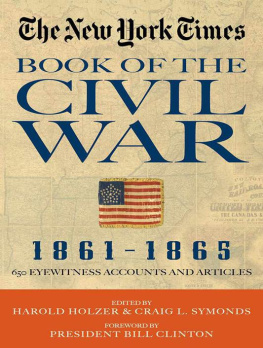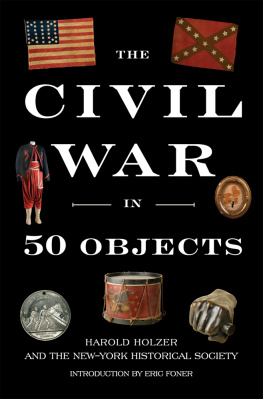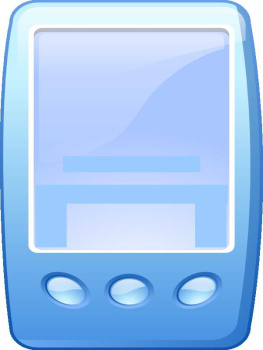Harold Holzer - The New York Times Book of the Civil War 1861-1865: 650 Eyewitness Accounts and Articles
Here you can read online Harold Holzer - The New York Times Book of the Civil War 1861-1865: 650 Eyewitness Accounts and Articles full text of the book (entire story) in english for free. Download pdf and epub, get meaning, cover and reviews about this ebook. year: 2010, publisher: Black Dog & Leventhal Publishers, genre: Politics. Description of the work, (preface) as well as reviews are available. Best literature library LitArk.com created for fans of good reading and offers a wide selection of genres:
Romance novel
Science fiction
Adventure
Detective
Science
History
Home and family
Prose
Art
Politics
Computer
Non-fiction
Religion
Business
Children
Humor
Choose a favorite category and find really read worthwhile books. Enjoy immersion in the world of imagination, feel the emotions of the characters or learn something new for yourself, make an fascinating discovery.
- Book:The New York Times Book of the Civil War 1861-1865: 650 Eyewitness Accounts and Articles
- Author:
- Publisher:Black Dog & Leventhal Publishers
- Genre:
- Year:2010
- Rating:3 / 5
- Favourites:Add to favourites
- Your mark:
- 60
- 1
- 2
- 3
- 4
- 5
The New York Times Book of the Civil War 1861-1865: 650 Eyewitness Accounts and Articles: summary, description and annotation
We offer to read an annotation, description, summary or preface (depends on what the author of the book "The New York Times Book of the Civil War 1861-1865: 650 Eyewitness Accounts and Articles" wrote himself). If you haven't found the necessary information about the book — write in the comments, we will try to find it.
The New York Times Book of the Civil War 1861-1865: 650 Eyewitness Accounts and Articles — read online for free the complete book (whole text) full work
Below is the text of the book, divided by pages. System saving the place of the last page read, allows you to conveniently read the book "The New York Times Book of the Civil War 1861-1865: 650 Eyewitness Accounts and Articles" online for free, without having to search again every time where you left off. Put a bookmark, and you can go to the page where you finished reading at any time.
Font size:
Interval:
Bookmark:

BOOK OF THE
CIVIL WAR
1861 1865
650 Eyewitness Accounts and Articles
EDITED BY
HAROLD HOLZER & CRAIG L. SYMONDS
FOREWORD BY
PRESIDENT BILL CLINTON

18501860
MayNovember 1860
December 1860March 1861
AprilMay 1861
JuneJuly 1861
AugustOctober 1861
November 1861January 1862
FebruaryMarch 1862
AprilMay 1862
JuneJuly 1862
AugustOctober 1862
November 1862January 1863
FebruaryApril 1863
MayJune 1863
July 1863
AugustSeptember 1863
OctoberNovember 1863
December 1863February 1864
MarchApril 1864
May 1864
JuneJuly 1864
AugustSeptember 1864
OctoberDecember 1864
JanuaryFebruary 1865
MarchApril 1865
AprilMay 1865
18651877
BY PRESIDENT BILL CLINTON
This is a book about a war and a newspaper: the Civil War the bloodiest and most transformative conflict in our history, and The New York Times, which recorded the events of the war and explained them to its vast audience.
In our own age of relentless information and opinion overload from 24-hour television news, talk radio, blogs, Facebook, Twitter, and the World Wide Web, the old-fashioned broadsheet newspaper with its narrow columns and tiny type may seem to be nothing more than a curious antique of limited reach. But such papers managed to elect presidents, propel (or depress) the national economy, sustain wars, and inspire the expansion of human freedom.
During the Civil War era, New Yorks daily newspapers gave an increasingly diverse population of local readers native-born New Yorkers, German and Irish immigrants, free African-Americans, and many others a vivid window into current events and forceful opinions on the most important issues. Their power to inform and persuade also reached well beyond their hometown base, through national editions that reached hundreds of thousands of people from coast to coast, an enormous audience for the period.
This golden age of newspapers did not necessarily guarantee readers greater reliability than the noisy outlets we have today. Unlike todays big urban dailies, nineteenth century papers did not pretend to be neutral and impartial dispensers of information. They were openly and proudly partisan. The New York Herald was the conservative-leaning Democratic paper; The New York Tribune was the paper of the liberal Republicans; and The New York Times was the paper of the establishment Republicans. (Of course, there has been some realignment in the positions of the major parties since Lincolns time!)
This book vividly reminds us just how strongly the Republican newspapers supported the Union during the Civil War, while the northern Democratic papers questioned and attacked the policies and practices of Lincoln and his administration and those published in the South supported the rebellion and the Confederacy. They were, in effect, the Fox News and MSNBC of their day. The Times, which in modern times has been called the Gray Lady, was anything but back then.
Even then, however, as this collection shows, The Times pioneered a somewhat different, subtler brand of journalism. Though the paper was unabashedly pro-Republican its founder, Henry Raymond, had served as the Republican speaker of the State Assembly The Times promised from the outset of the war to seek truth, avoid extremism, and strive for consensus. At a time when newspapers routinely used the kind of inflammatory language we currently associate with talk radio, this flagship of American dailies all but invented the policy of offering straightforward, temperate, and credible reporting.
Still, its efforts at restraint shouldnt be overstated. Readers who sample this collection edited by historians Craig Symonds and my friend Harold Holzer will see that its viewpoint was pro-Union and pro-Lincoln. The Times earnestly supported the war to suppress the Rebellion and, later, cheered the Emancipation Proclamation and the recruitment of African-American soldiers to fight for their own freedom. It condemned weak-kneed Unionism and urged loyalty to the Lincoln administration. Moreover, from the ardor and the emphasis on specific issues evident in the articles, it becomes clear that The Times did more than cheer from the sidelines: it helped spur a sometimes weary North to maintain the struggle to restore the Union and provide the new birth of freedom that Abraham Lincoln spoke of so eloquently at Gettysburg. Because there was no live coverage of momentous events, newspapers like The Times gave Americans their only record of the words Lincoln spoke that day. In doing so, it helped create what today we call the first draft of history.
Presidents of that era held no news conferences or daily briefings. Nor did they employ press and public relations specialists to defend their programs and hone their messages. Instead, they relied on friendly newspapers to print their letters and public statements. Abraham Lincoln made great use of this method of communicating with the American people, thanks in no small measure to The Times.
Times editor Henry Raymond continued running his newspaper even after he assumed the role of chairman of the Republican National Committee and began raising funds for Abraham Lincolns re-election campaign. There is no modern example of this kind of open political participation by journalists. Imagine the outcry today if the head of one of the major television networks assumed chair-manship of one of the major parties. During the era of the Civil War, such partisanship was not only tolerated, but accepted. Today independent groups issue reports on positive or negative bias in the coverage of candidates and officeholders, while media outlets routinely deny that it exists. Readers of this collection will decide for themselves how effective, responsible, and appropriate the system was then, and whether todays coverage would serve the public better if more media declared their sympathies openly.
For most Americans of the Civil War era, newspapers were the sole source of information social or political for a news-hungry population. They were there every morning for a penny or two. Often brilliantly written, they brought the Civil War with all its terror, grandeur, cruelty, suffering, triumph, and social change into American homes. They were the eyes and the ears of the people.
The New York Times not only reported these events; it influenced them as well. The first draft of history has never been more passionately presented, nor its role in history more worthy of examination and appreciation.

Civilians eagerly reading the latest war news on Broadway in New York City.
THIRTY MILLION AMERICANS lived in the United States during the Civil War. Nearly four million of them began the war as slaves and, by wars end, were free. More than 3.5 million men, black as well as white, served in uniform and fought on the battlefields of that war from Texas to Pennsylvania. For the remaining millions who did not serve, the war ultimately touched nearly every one of them in countless ways. Many had sons, fathers, brothers, cousins, husbands, or sweethearts fighting in the ranks who sent them occasional letters home; some witnessed battles that raged, in a few cases, in their own backyards; Northerners as well as Southerners lost homes and property as cities and towns became military targets. But the vast majority of Northerners experienced the war day to day by reading the countrys great newspapers. New York, then as now the publishing center of the nation, boasted more than half a dozen dailies (among some 174 newspapers nationwide), among which three morning papers exerted enormous influence and attracted readers beyond the citys boundaries: James Gordon Bennetts Herald, Horace Greeleys Tribune, and Henry J. Raymonds New York Times. Though newspapers offered the country its principal source of news the only source for most editors and reporters in mid-19th century America did not aspire to objective journalism as they do (most of the time) in the 21st century. Papers were expected to maintain a clear and decisive political point of view and reflect it consistently in editorials and news coverage alike. Democrats read Democratic papers, and Republicans read Republican papers, and their respective readers expected no diversity of views in either.
Font size:
Interval:
Bookmark:
Similar books «The New York Times Book of the Civil War 1861-1865: 650 Eyewitness Accounts and Articles»
Look at similar books to The New York Times Book of the Civil War 1861-1865: 650 Eyewitness Accounts and Articles. We have selected literature similar in name and meaning in the hope of providing readers with more options to find new, interesting, not yet read works.
Discussion, reviews of the book The New York Times Book of the Civil War 1861-1865: 650 Eyewitness Accounts and Articles and just readers' own opinions. Leave your comments, write what you think about the work, its meaning or the main characters. Specify what exactly you liked and what you didn't like, and why you think so.







